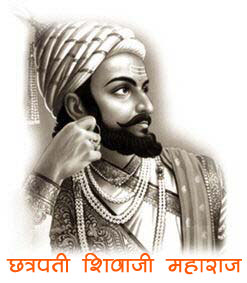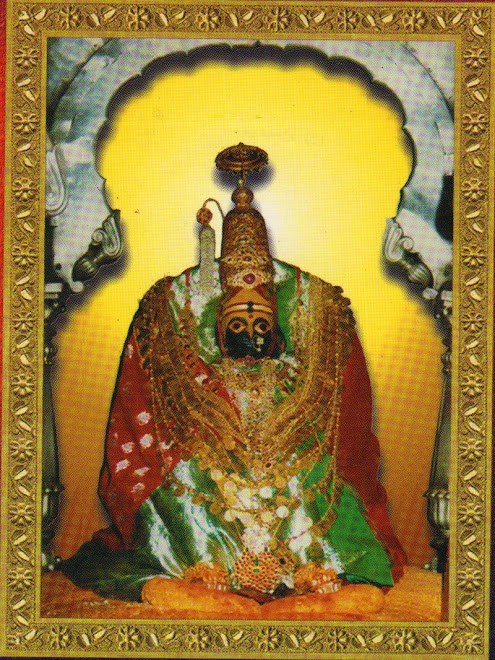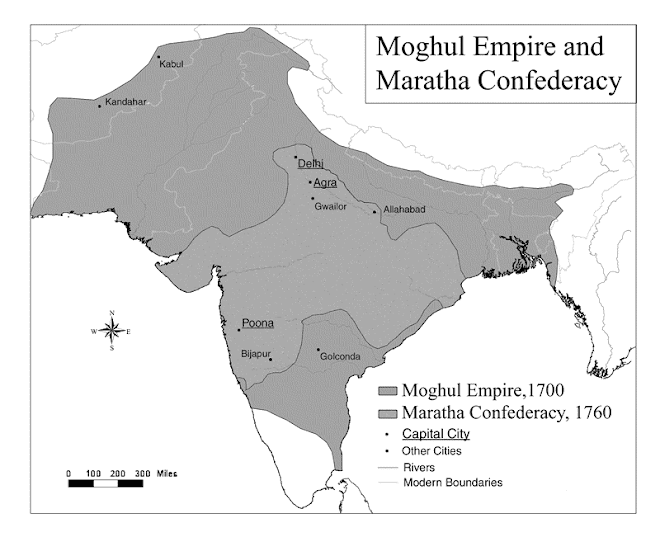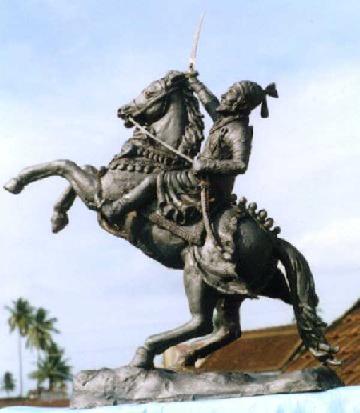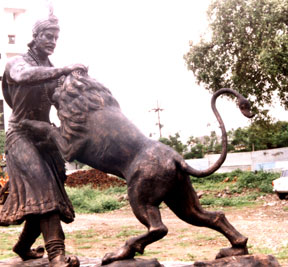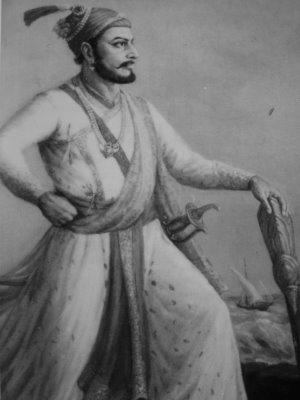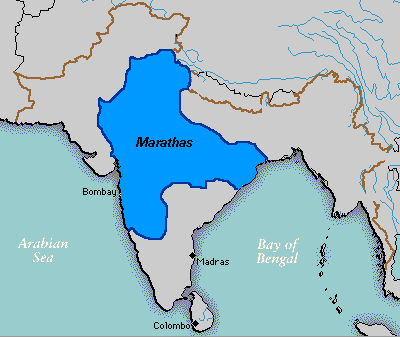Dandakaranya was the first identity of Maharashtra. Dandakaranya was the forest having its identity from Ramayana. We have found varied references of Maharashtra since Ramayana, like the ‘Panchawati’. As per new research it is confirmed that even before arrival of “Aryas” existence of human could be found in Maharashtra, but Marathas came in to picture just after the “Ashoka’s” when Maurya had lost their power and “Satavahanas” took over them in southern part of India called Deccan (Dakhhan).
They ruled over Maharashtra, Andhra Pradesh and some parts of Karnataka. They developed Junnar (PuneDistrict) as their Kingdom. GautamiputraSatkarni was the brave ruler of Satavahanas who expelled Shaks and Kushanas out of Maharashtra and Saurashtra, and started new calendar (Sanvastar in Marathi) called “ShalivahanShake” which is still in use in Maharashtra.Few documentary in Marathi Language was also started by the Satavahanas, but Marathi language was full-blown at the time of Yadavas.Raja Mahadevrai and Ramdevrai announced Marathi as their official language and then onwards Marathi got a good peak and took over Kannada.
The Marathas had their own empire even before 12 th century, Yadavas ruled all over Maharashtra around 450 years. In the time of Yadavas of Devgiri who made Devgiri (current Daulatabad) as their Kingdom of Maharashtra. Yadavas Ruled around more than 450 Years when Islamic ruler Aladin Khilji took over the Yadavas in 13 th Century. They not only ruled Maharashtra but all over the India, Delhi was their kingdom.They ruled Maharashtra over 350 years when Chhatrapati Shivaji Bhosale took over them in 17 th Century. He was the person who found Maharashtra after defending Islamic rulers after 350 years with the help of Mawalas army. In 1674 he took Rajyabhishek on Raigad (The Maratha Kingdom) and started a new Calendar. Later his son Chhatrapati Sambhaji Bhosale ruled around 10 years. After Chhatrapati Sambhaji his step brother Rajaram (Ramraje) continued from 1682 till 1700. His successor Tarabai (Wife of Rajaram) ruled for 7 years till 1707 when Chhatrapati Shahu came out of custody of Mughals and took lead of Maratha Empire and started ruling all over Maharashtra with the help of Peshawas till 1749 AD. This was the period when Maratha power grew all over the India and Marathas captured Delhi (the capitol of Hindustan).
Early History
Although some Paleolithic remains have been discovered, Maharashtra enters recorded history in the second century BC, with the construction of its first Buddhist caves. These lay, and still lie, in peaceful places of great natural beauty, but could never have been created without the wealth generated by the nearby caravan trade routes between north and south India.
Origins
The name Maharashtra first appeared in a 7th century inscription and in a Chinese traveler's account. Its name may have originated from rathi, meaning "chariot driver" and referring to builders and drivers of chariots who formed a maharathis, a "fighting force." This region seems to have attained prominence as early as 90 A.D., when king Vedishri made Junnar the capital of his kingdom, thirty miles north of Pune. For the 900 years ending in the early fourteenth century, with the overthrow of the Devgiri Yadavs by the northern Muslim powers, no historical information in this region is available. In 1526, first Mughal king, Babar, established his prominanace in Delhi and soon the Mughal power spread to the southern India. The Mughals were to dominate India till the early eighteenth century.
Poet-Saints
The regions's first Hindu rulers, based in Badami, appeared during the sixth century, but the eighth-century Rashtrakutas achieved a greater authority. Buddhism was almost entirely supplanted throughout the entire country by the twelfth century, in what has been characterized as a peaceful popular revolution attributable largely to the popular poet-saints. Maharashtra was one of the main channels that helped the emotional and emotional bhakti school of Hinduism spread from southern to northern India, thanks here to work of Jnanesvara (1271-1296) whose commentary on the Bhagwad Gita, the Jnanesvari, was significantly written in the day-to-day spoken language, Marathi, as opposed to classical Sanskrit. The most famous of his contemporary poet-saints was the tailor Namdev (1270-1350), whose passionate devotional hymns caught the popular imagination. The tradition they established continued to flourish, even when forced underground by Islam, reaching its zenith in the simple faith of the anguished Tukaram (1598-1650), whose wife and son died in a famine, and Ramdas, the "Servant of Rama" (1608-1681). Ramdas, both ascetic and political activist, provided the philosophical underpinning behind the campaigns of Maharashtra's greatest warrior, Shivaji.
The Maratha Reign
In the sixteenth century, regional Muslim powers like Nizamshahi, Adilshahi, and Qutubshahi established their prominence in the Deccan region. They basically served the Mughal empire but were autonomous to an extent. One of them, Nizamshahi was located in Ahmednagar, a town 95 miles east of Pune. Maloji Bhosle, Grandfather of Shivaji served for the Nizam as a Sardar. In 1595, Bahadur Nizam II honored him as 'Raja' for his courage in a battle with Mughals and gave him the estates of Pune and the fort of Chakan, near Pune. This is generally considered as the starting point of the Maratha history.
The Reign of Shivaji (1627 - 1680)
Shivaji Bhosle, founder of the Maratha empire, was born in 1627, in the fort of Shivneri, 40 miles north of Pune. In 1629, Shivaji's father Shahaji, who had succeeded his father Maloji, in Pune and Chakan, disengaged himself from the service of the Nizamshahi. Consequently, in 1635 the Nizam's army attacked Pune. Shahaji surrendered and his estates were returned to him. Soon, Shahaji put Dadaji Kondadev in charge of Pune,and as a caretaker for the Shivaji while he joined the Adilshahi in Vijapur, aprox. 400 miles south of Pune, which was soon to emerge as the most important power in the region as the other local powers slowly diminished.
In Pune, Dadoji built a palace 'Lal Mahal', for Shivaji and his mother Jijabai. At the age of sixteen (1643 AD), Shivaji took great delight in stirring up his friends' hopes and nursed the thought of becoming independent. He took the oath to make the land free at the fort Torna at the age of sixteen. This was the start of his lifelong struggle against Mughals and other Muslim powers. By 1647, Shivaji had captured two forts and had the complete charge of Pune. In 1657, he committed his first act of hostility against the Adilshahi by plundering a large booty in Ahmednagar. Thus, began a sequence of attacks on the Adilshahi.He slowly started capturing forts in the region, Purandar, Rajgad, Torna being most notable of his first achievements.
Disturbed by his continuing success, Adilshahi sent a famous Sardar, 'Afzalkhan' to destroy Shivaji. Afzalkhan knew that Shivaji's army, which was much smaller than his huge force would be unable to fight him on open land. He tried all the tricks in the book to make him fight on plains, but Shivaji was no less clever. He convinced Khan that he was very much afraid of him and requested him for a meeting at a place near Vai ( 100 miles south of Pune) which was densely wooded, mountainous region, and ideal for his army to fight. Khan still had plans to kill him in the meeting and Shivaji knew it well. Ultimately it was Khan who was killed and his unsuspecting army was completed washed out by Shivaji. After this, Shivaji went on a winning spree and spread his reach till Panhala near Kolhapur.
Meanwhile, Aurangzeb got concerned by Shivaji's rise to power. It was now clear that local Muslim Powers were unable to stop him. So he sent a huge Army, led by Mirzaraje Jaisingh to defeat Shivaji(1666). Jaising's army was much stronger than Shivaji and soon he lost most of his important forts. Realising that he was fighting a losing battle, he signed a treaty with Mirza and agreed to serve Aurangzeb, his young son, Sambhaji being made a sardar. He went to Delhi with Mirza to meet Aurangzeb. Aurangzeb gave a humiliating treatment to Shivaji and soon put him under house imprisonment under some excuse. It looked certain that Shivaji will be killed sooner or later by Aurangzeb. But this was not to happen, fortunately, for Maratha kingdom. Shivaji made a clever plot to escape and escaped with Sambhaji to south.
After this turning point, Shivaji never looked back and slowly regained his lost glory. By 1673, he had control over most of western Maharashtra and had made 'Raigad' ( Dist. Raigad , 150 miles southwest of Pune) his capital. He was ceremeniously enthroned as a sovereign king in 1673. By 1680, the year of Shivaji's death, nearly whole of the Deccan belonged to his kingdom. He had developed an efficient administration and a powerful army. He also encouraged a spirit of independence among the Marathas that enabled them to withstand for 150 years all attempts to conquer them. Shivaji's achievements amongst monumental difficulties were really spectacular and that is why he holds the highest place in Maratha history.
The Period of Unstability - 1680 to 1707
Shivaji was succeeded by his son Sambhaji. He showed the same vigor as his father, but was taken prisoner and executed by the Mughal ruler Aurangzeb, in 1689. Rajaram, Sambhaji's younger brother then took the throne, since Sambhaji's son, Shahu was still a minor. The death of Rajaram in 1700 seemed to end the power of the Marathas, but Tarabai, the elder widow of Rajaram, put her young son Shahu on the throne, at the tender age of ten, and continued the struggle against Aurangzeb who had come to south with the sole purpose of destroying Maratha kingdom. Between 1700 and 1703, Aurangzeb captured the fort of Sinhagad, near Pune. During the siege, his son prince Muhuil-Mulk died; so Aurangzeb changed Pune's name to Muhiabad, in the prince's honor. Shahu continued to fight against the Mughals and captured Rajgad, the former capital of the Maratha territory. The fight against the Mughals ended with the death of Aurangzeb in 1707 which was another turning point in Maratha history. After Aurangzeb, Mughal power never regained its status as main power in India and Balance of power shifted towards Marathas, which was soon to be controlled by Peshwas.
The Peshwe Dynasty - 1712 to 1818
Balaji Vishwanath - 1712 to 1721
In 1712, Shahu died of smallpox and his minister or peshwa, Balaji Vishwanath took over the throne.
Negotiations between the Mughal court of Delhi and Balaji Vishwanath enabled him to send a large Maratha delegation to Delhi to assist the Mughals. The year 1718 marked the beginning of the Maratha influence in Delhi, to which they remained closely acquainted, till 1803. Balaji Vishwanath's health had suffered considerably, and he died in 1721.
Bajirao Peshwa ( Pahila Bajirao ) - 1721 to 1740
Bajirao, his elder son was awarded the title of peshwa after the death of his father . It was Bajirao's dream to extend the Maratha empire to North India. By this time, Pune had regained its status as capital of Maratha Kingdom from Rajgad. Rajgad was made capital by Shivaji beacuse it was a safe place, high in the moutainous, wooded area. As Pune was in plains, it always had a threat. By 1720's, Maratha power was spreading in large areas and the threat of local battles fought over forts did not exist much. Pune remained the capital till the end of Maratha empire in 1818.
In 1734, Bajirao captured the Malwa territory in the north, and in 1739, his brother Chimnaji drove out the Portuguese from almost all their possessions in the northern Western Ghats. Bajirao diedi in 1740 and left three sons behind him. It was Bajirao who built the 'Shanivarwada', the residence and ruling place for the Peshwas.
Nanasaheb Peshwa - 1740 to 1761
Nanasaheb succeeded Bajirao as Peshwa in 1740. He had two brothers, Raghunathrao, who later betrayed the Marathas and joined hands with the British, and Janardan, who died in his early youth.
Nanasaheb was ambitious and a multifaceted person.In 1741, when his uncle Chimnaji died, he returned from the northern districts and spent nearly a year improving the civil administration of Pune. The period between 1741 and 1745 was of comparative calm in the Deccan. Nanasaheb encouraged agriculture, protected the villagers and brought about a marked improvement in the state of the territory.
The scene changed in 1751, when the Mughals, supported by the French, advanced towards Pune, totally destroying every village in their way. The Marathas fought with great determination, and nothing but the French artillery saved them from total defeat. In 1754, Raghunathrao, Nanasaheb's brother started on an expedition to conquer Gujarat, the state north of Bombay. In 1756, Nanasaheb marched south to attack Karnatak. In the meantime, news spread that the war had broken out between the English and the French, in Europe.
In 1756, the fall of the formidable navy formed by Shivaji gave British their chance to regain importance in the region. The navy was headed by Kanhoji Angre and its destruction was a cruical blow to Maratha sea power. It was a sad outcome of neglect of navy by Marathas which turned out to be a horrible mistake. Marathas never regained control of the sea after that.
In 1761, the Marathas were defeated at the third Battle of Panipat against Ahmadshah Abdali , a great warrior from Afganistan. Marathas were fighting to save Delhi Sultanat and consequently their power in the north. NajibUddowla was the person responsible for calling Abdali. 14th January, 1761 was the D-Day. This was a cruical blow to the rising Maratha power from which they never recovered. They lost more than 100,000 men and dozens of important Sardars in the battle. Nanasaheb Peshwe ( Balaji Bajirao ) lost his brother, Sadashivrao ( After whom the Sadashiv Peth in Pune is named ), and also his first son, Vishwasrao, in this battle. This news shattered Balaji Bajirao, who died shortly afterwards, in the temple on Parvati hill in Pune. The Maratha power was at the zenith of its glory during Balaji Bajirao's (also called Nana Saheb Peshwa) reign. It never fully recovered from the crushing defeat at Panipat.
'Thorale' Madhaorao Peshwa - 1761 to 1772
Madhavrao, his second son then took over, but had to constantly face administrative disputes with his uncle, Raghunathrao. Despite of this, he achieved many remarkable victories and restored the shattred Maratha kingdom to a large extent. His outstanding achievements included defeat of Nizam (Hyderabad), Hyder (Karnataka) and Bhosle of Nagpur. He also had to fight wars with Raghunathrao whose greed for power never waned. Ultimately, Madhavrao took Raghunathrao prisoner in 1768; the same year when the Nizam attacked Pune.He was eventually defeated. Madhavrao, also called 'Thorale'or Greatest Madhavrao, is entitled to special praise for supporting the poor and for his sense of justice. Ramshastri Prabhune, the chief justice, has become a legend for his work. The people who rose to power in his rule were Mahadji Shinde, Nana Phadnis and Haribhau Phadke who became the key figures in the power structure after his death. He took ill in 1771 and died in 1772 at an early age of 27, causing yet another blow to recovering Maratha power.
Narayanrao Peshwa - 1772 to 1773
Narayanrao, Balaji Bajirao's third son succeeded the throne at Shaniwarwada as the next Peshwa. He neither had the courage to take any bold decisions nor administrative skills and soon became very unpopular among the people. In 1773, Raghunathrao, who had been imprisoned by Madhavrao, in a room in the palace in Pune, escaped with the help of the Gardi people . Narayanrao was murdered at the Shaniwar wada , owing to a conspiracy by Anandibai, Raghunathrao's wife.
'Sawai' Madhaorao Peshwa - 1774 to 1795
Raghunathrao was proclaimed the next peshwa, although he was not heir to the title. Narayanrao's widow gave birth to a son, Sawai Madhavrao, who was legally the next peshwa. Raghunathrao tried to maintain his kingdom by signing treaties with the English , and relied on them for manpower in exchange for money and territory. However his plans did not succeed. Raghoba was displaced from power by a clever plot by the 12 Maratha sardar's " Barambhainche karasthaan" ( Plot by 12 people ) including Nana, Holkar, Phadke Shinde . Sawai Madhavrao was then declared the next Peshwa. As he was only one year old at that time, Nana Phadnis became the main administrator with Phadke,Shinde,Holkar taking care of Military duties. These people handled the Peshwai well and with great unity till the premature death of Sawai Madhaorao in 1795. They defeated the rising British Power in 1784, near Pune and halted their advancements, temporarily. Sawai Madhaorao's death was the last blow to the Maratha empire and all the unity among its leaders vanished after his death causing a downfall of Peshwai in a short time.
'Second' Bajirao Peshwa - 1795 to 1802
Raghunathrao died in 1782, leaving behind him, two sons; Bajirao, who in 1817 confronted the British at the Battle of Kirkee, in Pune; and the younger, Chimnaji Appa. Bajirao became the next Peshwa after Madhaorao's death. Nana was still the administrator and the Peshwai remained in stable condition till his death owing to his superb administrative skills. Nana died in 1800 and Pune fell into the hands of the Sindia's ( Shinde) ; the former chiefs of Nana's army. They remained in power for a short while and in 1802, Bajirao reestablished himself in Pune, by signing the treaty of Bassein with the British. This essentially ended Peshwai , establishing British supremacy in the region. The capturing of the Ahmednagar fort in 1803, proved British supremacy in the Deccan. In 1804, General Wellesly proclaimed the Deccan in a state of chaos, established military rule and the Peshwas remained rulers for name's sake.
The British Raj - 1818 to 1947
Towards the end of 1805 Sir James Mackintosh, the Chief Justice of Bombay (1804-1811), came from Bombay to visit Colonel Close, the Resident at Pune. The Residency on the 'Sangam'(confluence of the Mula and Mutha rivers) Mackintosh describes as a set of bungalows, fitted conveniently and luxuriously. Pune city had its principal streets paved with stone, and was reckoned one of the best built native towns in India. The Peshwa's residence, that is the Shaniwar wada, added to Pune's glory. Between 1805 and 1811, under Colonel Close and for a short while under Mr. Russel, affairs went smoothly in Pune.
In 1811, Mr. Russel was succeeded by Lord Mountstuart Elphinstone. Bajirao was very disloyal to the British, and in November of 1817, he declared war against them. This battle was fought at Kirkee, that is the Cantonment area, in the east of Pune. The Peshwa fled and the power of the country passed from the Peshwas to the British by 1819. The rest of the nineteenth century witnessed a few minor uprisings in and around Pune, but the British established their supremacy. As the Maratha's were the key power in India at this time, their fall clearly marked the begining of British Rule in India.
The first step towards establishing a municipal government in the city of Pune, was taken in 1856, when the Pune Municipality came into existence under the Act of 1850. The fact that Pune is not recognized as a major tourist center, is probably because it cannot boast of outstanding artistic specimens of architecture, like those of Delhi or Agra. Yet, it is rich in its associations with the past.
In the early 20th century, the whole of India was in revolt against the British; yearning for freedom. Mahatma Gandhi launched his movement of nonviolence, and people participated by the thousands in the 'Chale Jao' ('go away') struggle. Paradoxically, Pune witnessed violence when the Chaphekar brothers killed a British police officer by the name of Mr. Rand. On one hand, as the violence overrode the city, improvements were made in the education of women and the abolition of child labor. Independence was attained in 1947, but that was not the end of violence.
Modern Maharashtra - 1947 to Present
At Indian Independence in 1947, western Maharashtra and present-day Gujarat were joined as Bombay state. The eastern districts were then part of Hyderabad State, but were later added to Bombay in 1956. The present state was formed in 1960 when the Marathi and Gujarati linguistic areas of former Bombay state were separated. Bombay city became the capital of the new state.
Marathas are a blend of the Warrior and Agrarian classes, speaking Marathi and generally having their roots in Maharashtra. They are also found in large Nos in Karnataka, Goa, and Madhya Pradesh & Gujarat. There are contradictory theories about the Historic origins of Marathas and hence are not discussed here. A few Maratha clans claim themselves to be Kshatriyas (Warriors). Some such families were the Bhosales, Ghorpades, Jadhavs, Nimbalkars, Mores, Manes, Ghatges, Dafleys, Sawants, Shirkes, Mahadiks and the Mohites. The prominent Maratha families mentioned above were serving under the Nizam Shah of Ahmednagar and Adil Shah of Bijapur. These families are generally referred as the 96 clans or kulis which comprise of 96 different main clans with their different sub clans. Marathas are descendents of Rashtrakuts, Mauryas, Pariharas/Parmar (Pawar), Pratiharas, Shilahars, Kadambas, Yadavas, Chalukyas and many other royal clans in India.Maloji Bhosale (c.1552-1606) then the patil of verul joined Nizam Shah with a small band of cavalry. His son, Shahaji (1599-1664) served under Nizam Shah and Adil Shah, and came to prominence as a leading General. His son Shivaji (1627-1680) established the Hindavi Swarajya (Sovereign Hindu state), which happened to be the nucleus of the Maratha power that came into being later on. The Marathas, who had been till then serving as Deshmukhs (Jagirdars) to the Muslim rules, now had their own king and kingdom. The majority of Marathas, however belong to the peasantry class. The dividing line between the Kshatriya classes and the peasantry classes has become thin with the passage of time.A lot of matrimonial alliances are also taking place amongst them, unlike those in North or South India. The Maratha army and the administration also had people from all castes taking pride in it.The fanatic Brahmins of those times had refused to coronate Chhatrapati Shivaji Maharaj and subsequently Rajarshi Shahu Maharaj of Kolhapur since they didn't consider Marathas, as 'Kshatriyas'. The Brahmins declared that 'Only Kshatriyas are entitled to be crowned as the Kings' and Marathas being 'Shudras' were not entitled to be crowned. Chhatrapati Shivaji brought Gagabhat of Varanasi to establish his lineage with the Sisodias (Rajputs) of Rajasthan & testify his being Kshatriya, whereas the great social reformer Rajarshi Shahu Maharaj extended the vedic rights to non brahmins and empowered them do the jobs of the brahmins.
Rajarshi Shahu realised the falacy in the caste system and corrected it by bringing all the sections of the society on one platform to fight this brahmin fanatism. Throughout his life, he struggled for the upliftment and education of the downtrodden. . It is a worthwhile to see the majority lot of Maharashtrians identifying themselves as Marathas. It is a case of inculcation of pride in masses, a case study for sociologists.Marathas consider themselves to be the saviours of Hinduism who fought the onslaught of fanatic Mughal Emperor Aurangjeb. It is generally agreed by Historians that had the Maratha power not been there after the Mughals, the whole of India would have become Pakistan after Independence.The death of Chhatrapti Shivaji in 1680 and his son Sambhaji in 1687 pushed the Maratha kingdom in the period of instability upto 1707. The tiny Maratha kingdom , established by Chattrapati Shivaji was expanded by the Peshwas, who were the Brahmin Prime Ministers. The real credit for expanding the Maratha kingdom goes to Bajirao Peshwa I(1721-1740) . The Peshwas subsequently ruled the Maratha Kingdom as defacto rulers. The Maratha Sardars or chieftanslike Gaekwads of Baroda, Shindes of Gwalior, Holkars of Indore expanded the power in North India and became powerful after the Peshwas.They then established their own kingdoms. At one time, the Marathas rule spread from Attock in Paktoonistan to Bengal (beyond Cuttack) in East India to become a Maratha confederacy. The Great Maratha, 'Mahadji Shinde' was the kingmaker at Delhi who played a dominant role in deciding the fate of Delhi rulers but never thought of occupying the throne for himself.In the battle that took place near Delhi ,after the Mughal power declined, the Marathas conclusively defeated Afgan-Rohila forces led by Shah Abdali & Najib Khan in 1756. Najib Khan surrendered to the Marathas and became their prisoner. This battle liberated Punjab from the Muslim dominion after 800 years. The Marathas chased and drove the Afghans back to Afghanistan. Thereafter Najib Khan woed Malharrao Holkar to his side and in return secured his release. Thus Marathas released Najib Khan. He again invited Shah Abdali for his second invasion in 1759. Marathas formed alliance with the Jat King Suraj Mal of Bharatpur This alliance led by Shrimant Sadshiv Rao Bhau and Shrimant Vishwas Rao (the Peshwa Shrimant Balaji Baji Rao's son) won spectacular victories and captured Delhi and Kunjapura. This was the time when the entire North & Central India was in the Maratha Command.Here the alliance developed cracks about handling of Delhi matters and ultimately split. Suraj Mal withdrew from the alliance. The Marathas then marched upto Panipat and blockedg the way of the Afghans back to Afghanistan, instead of continuing their attacks to completely defeat the partly defeated Abdali and Najib Khan. Seeing their way back to their homeland blocked, the Afghans in turn, blocked the way of the Marathas back into the Deccan. This standoff continued for a few months, while the Afghans cut-off all supplies to the huge Maratha army. The Afghans with Najib Khan meanwhile recaptured Delhi and Kunjpura. On the decisive day of 14th January 1761, the Marathas decided to break-through the Afghan blockade and re-enter Deccan. The disastrous battle saw about one hundred thousand Maratha troops killed in a matter of eight hours. Nanasaheb Peshwe (Balaji Bajirao) lost his brother, Sadashivrao, and also his first son, Vishwasrao, in this battle. Nanashaeb , unable to bear the shock also died shortly. It was one of the worst defeats for Marathas, Hinduism & the Indian Nationalist Forces. The dream of bringing India under one unified Hindu rule was thus shattered. The Afghans too suffered heavy losses and decided enough was enough and went back to Afghanistan. Abdali never returned to India after this stormy campaign. The Peshwas also lost control on the Maratha empire thereafter and the Maratha Generals like Shindes (Gwalior) and Holkars (Indore) consolidated themselves after this, in the North & Central India.For Marathas 'Panipat is a synonym for Disaster' and it haunts even the present generation of Marathas.Click on the link 'Marathas - Page 2' given below, to go to page-2 of this website.
Saturday 30 August 2008
Subscribe to:
Posts (Atom)
